
A1: Captain, FA Detachment Commander, 10th SFGA; Bad Tölz, West Germany, 1956
This officer wears winter semi-dress uniform, often referred to as ‘pinks and greens’ due to its appearance in bright sunlight. He wears the still-unofficial, German-made ‘Munich’ beret, which is of a lighter green than the later ones. Over the temple he wears the Group’s ‘Trojan Horse’ badge. The Ranger and unofficial gold-yellow-on-teal-blue Airborne tabs are worn over the newly authorised Special Forces patch.

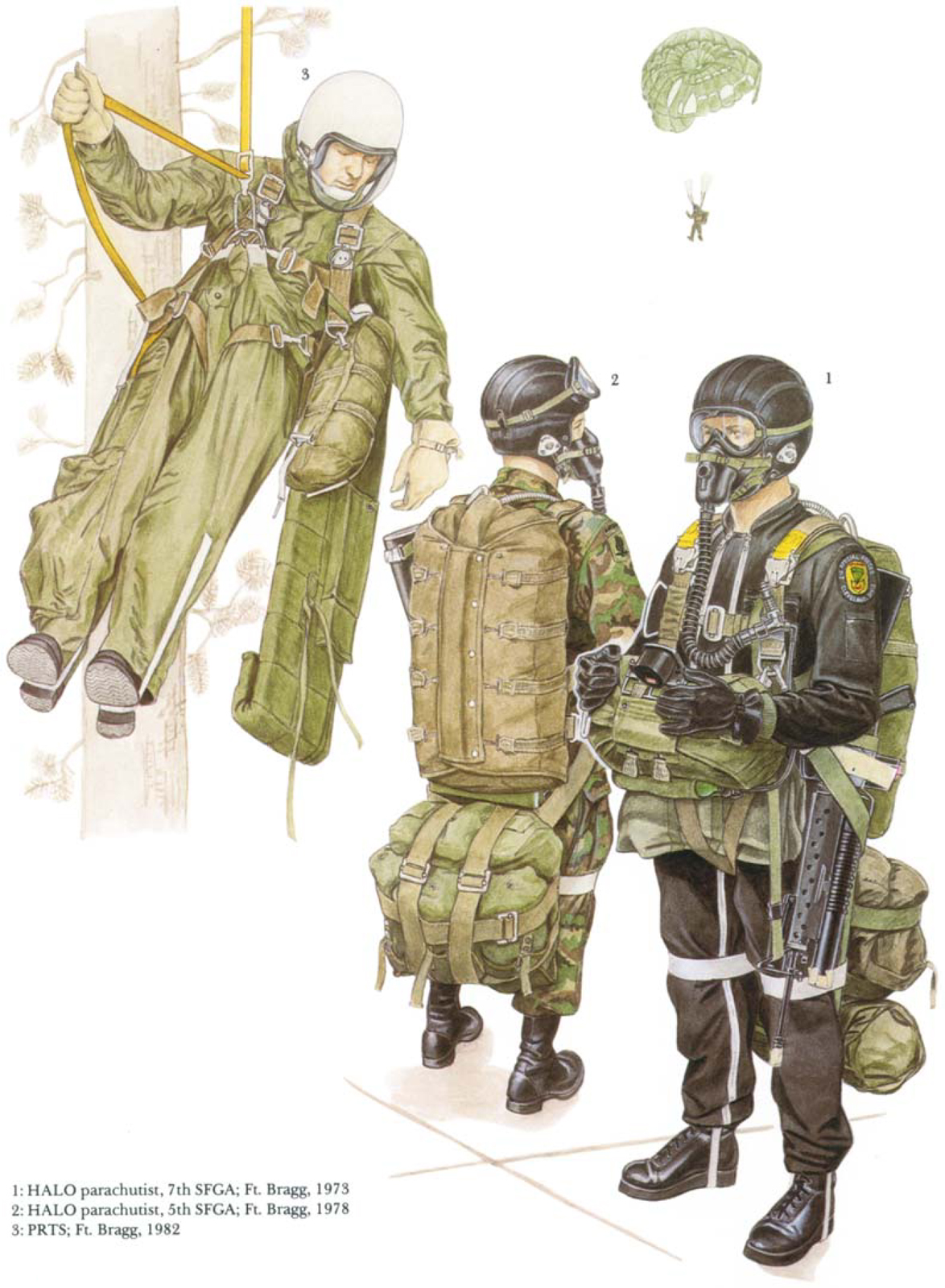

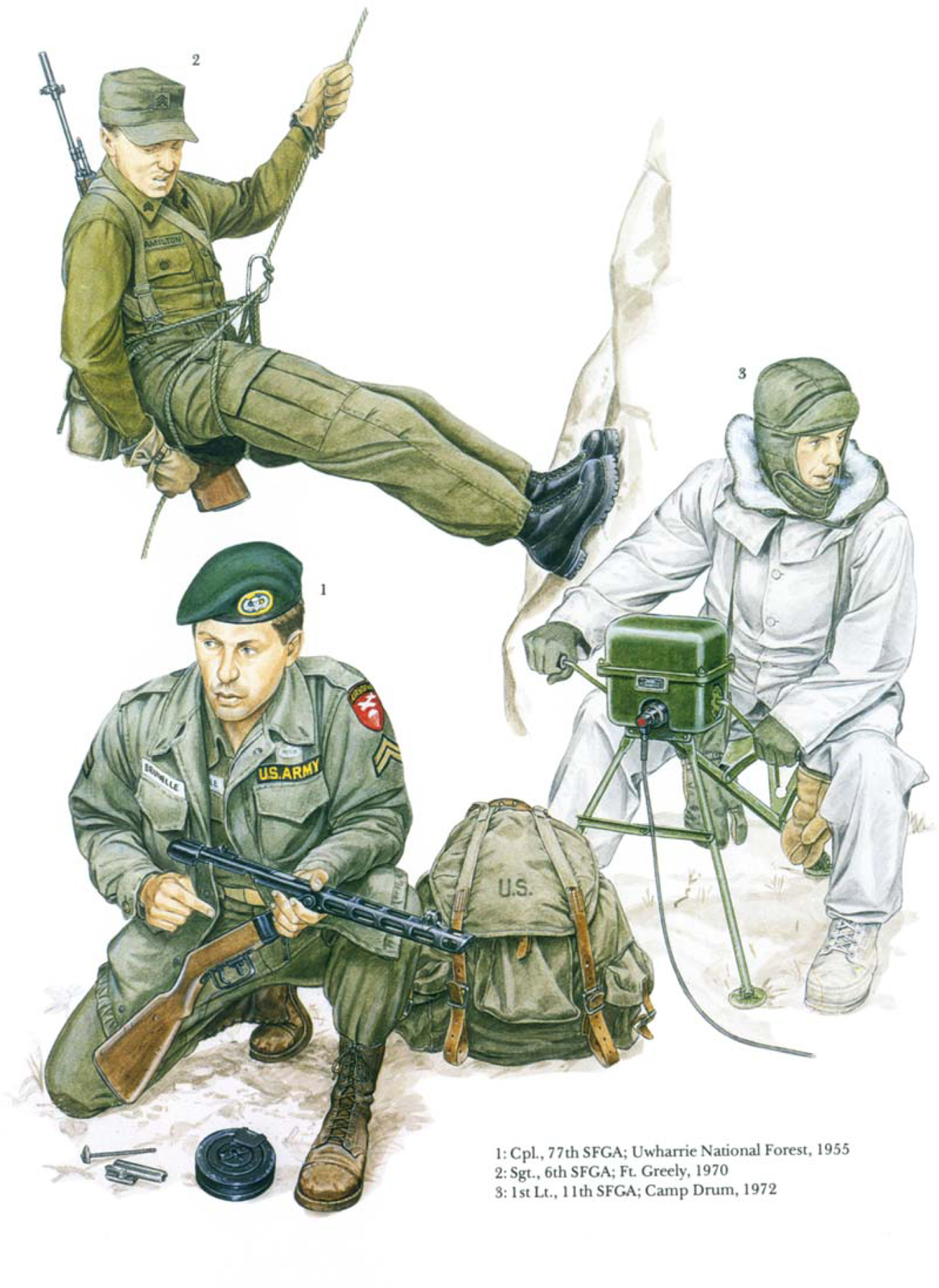

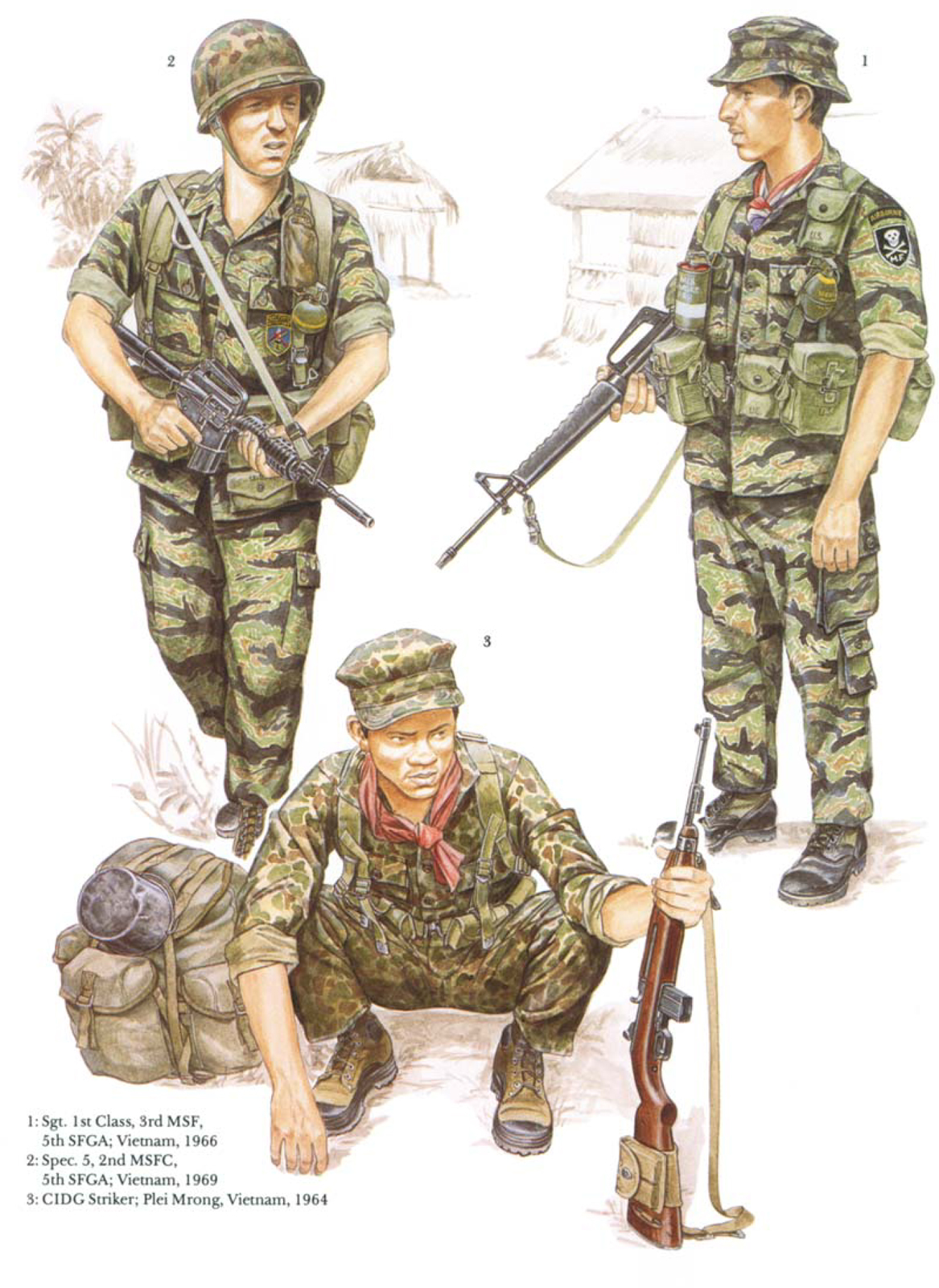

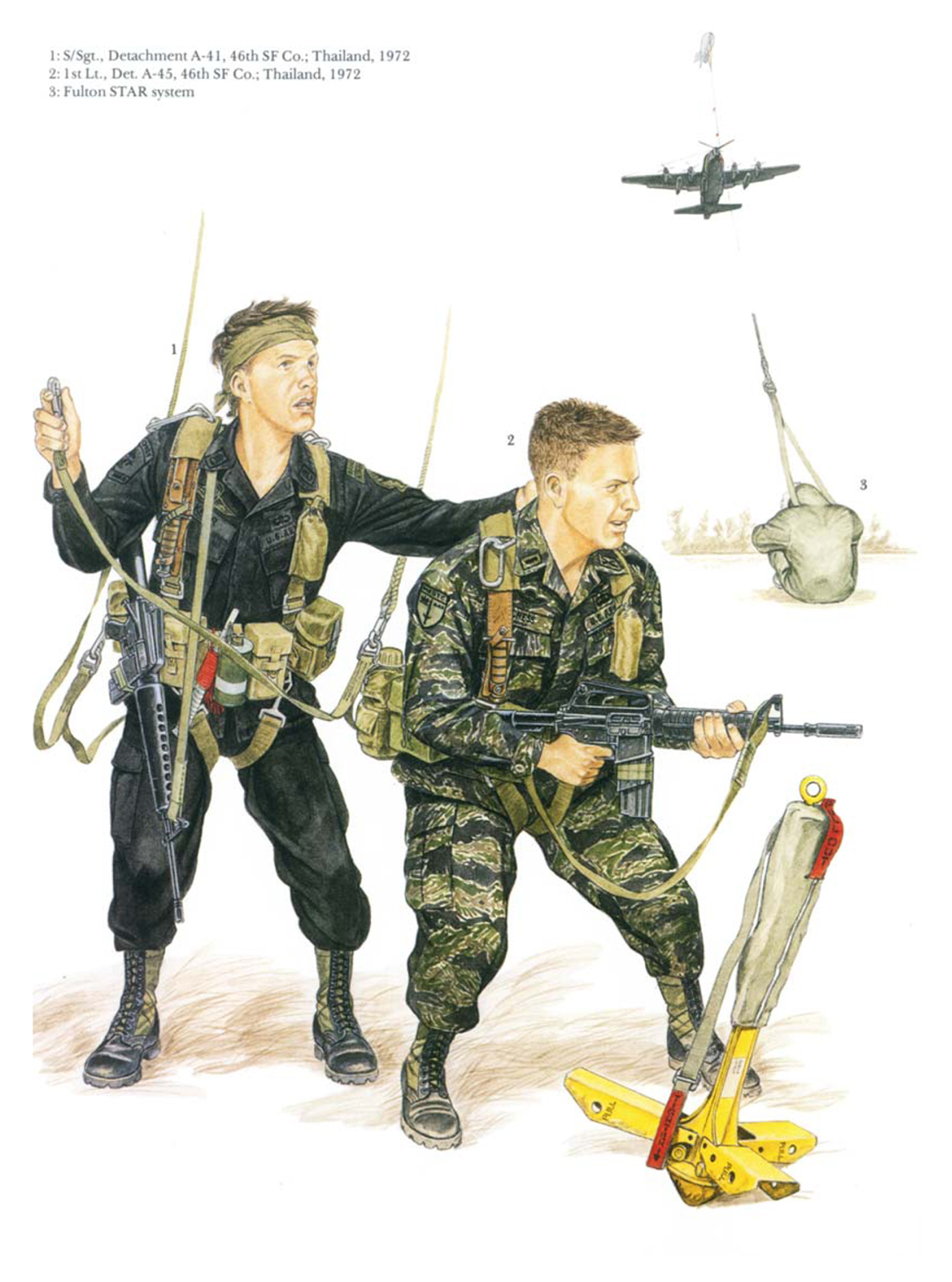


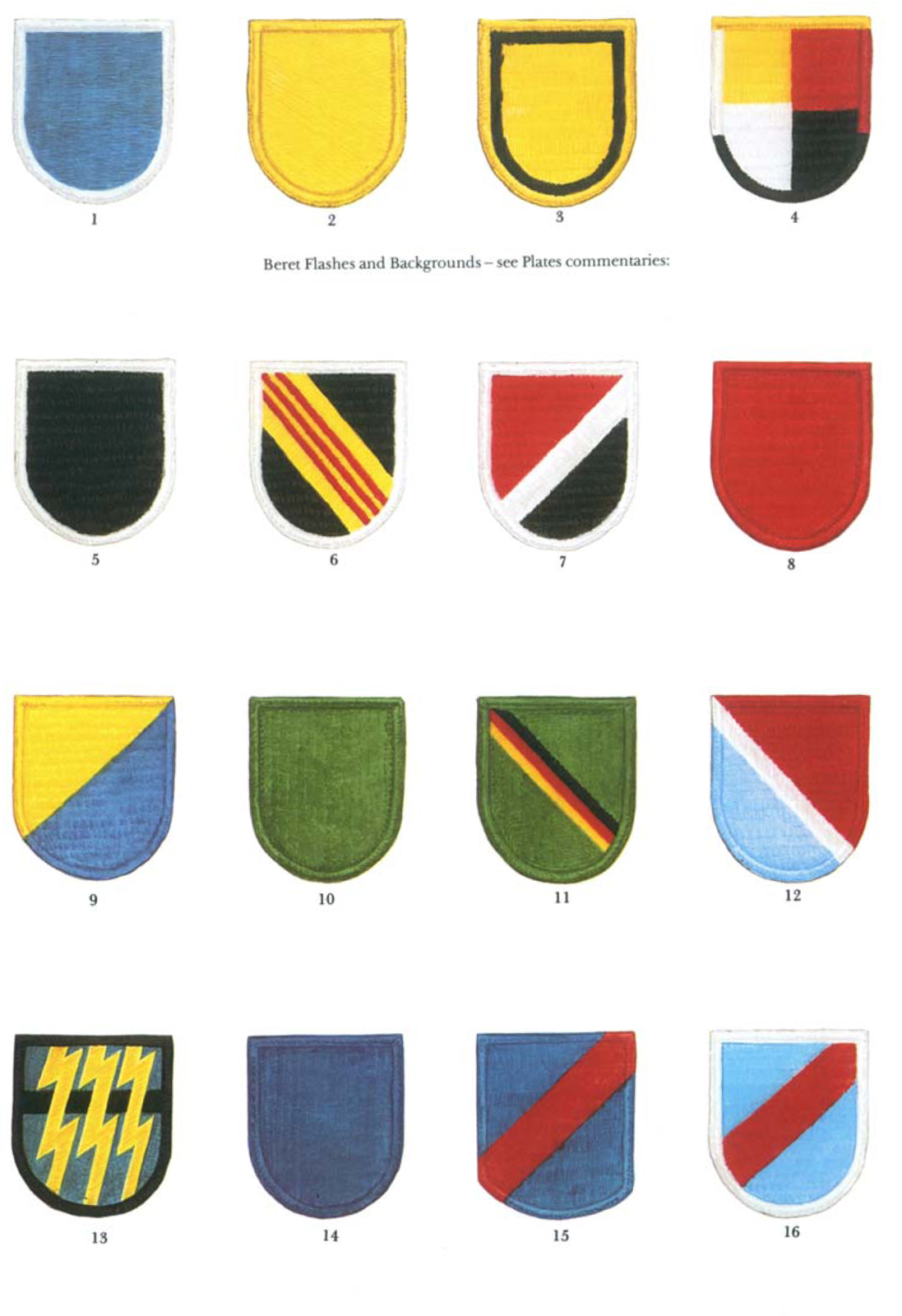

A2: Master Sergeant, FA Detachment Sergeant, 1st SFGA; Ft Buckner, Okinawa, 1960
The A Team Operations Sergeant, as the senior enlisted man on the team, had the additional duty of ‘Team Sergeant’. In a sense he was the first sergeant of the team and was, and is, often referred to as ‘Top’. Over his right chest pocket he wears Nationalist Chinese master jumpwings: foreign jumpwings (or other qualification badges) are often worn by US personnel in this position when awarded by Allied units with which they have trained. Members of the 1st SFGA had numerous opportunities to obtain foreign jumpwings, and some individuals had different wings on virtually every uniform. The Army Khaki uniform was available in issue cotton or privately purchased tropical worsted wool; often referred to as ‘TWs’, these were much favoured by officers and senior NCOs.

Camp Binh Than Thon, IV Corps Tactical Zone, Detachment A-413, photographed in 1969. This shows a typical improved Strike Force fighting camp. (US Army)
A3: Brigadier General William P. Yarborough, Commandant, US Army Special Warfare Center; Ft Bragg, NC, 1961
President John F. Kennedy, considered by many to be the ‘patron saint’ of SF, visited Ft Bragg on 12 October 1961 for a demonstration of SF capabilities. It was the first time that SF troopers appeared en masse wearing the green beret with official sanction. When the President stepped from his limousine to be greeted by Gen. Yarborough, he asked, ‘Those are very nice. How do you like the green beret?’ The general replied, ‘They’re fine, sir. We’ve wanted them for a long time.’ Later, in a letter to Gen. Yarborough thanking him for SF’s efforts, the President wrote, ‘I am sure that the Green Beret will be a mark of distinction in the trying times ahead.’ Little did he know of the future trials that SF would endure and survive; but one of its longest battles, for the beret, had been won. The camouflage flash was one of a kind and was worn only by the general. He wears the cotton utility uniform or fatigues. The Third US Army patch with Airborne tab was the authorised insignia for the Special Warfare Center until 1962. The general had been awarded the combat infantryman’s badge, but seldom wore it on field uniforms.
B1: NCO, High Altitude–Low Opening Parachutist, 7th SFGA; Ft Bragg, NC, 1973
The High Altitude–Low Opening (HALO) concept was developed by the 77th SFGA in 1957–58, and involves the principles of sport skydiving modified to meet the requirements of military freefall. Its purpose is to provide a means of parachute insertion into the area of operations, while making it difficult to detect and/or destroy the aircraft due to its extremely high altitude of up to 40, 000 feet. The HALO Course is conducted by the Special Warfare Center, as well as by some of the groups in the past. Groups normally maintain some A Teams that are fully HALO-qualified. This jumper is wearing his own jumpsuit and French-made jumpboots—an outfit often worn for training, but not for actual deployment. He wears the MC-3 leather jump helmet with MBU3P oxygen mask: oxygen is required at over 10,000 feet. In the jump aircraft the mask hose is plugged into an on-board oxygen system; just prior to the jump it is connected to the ‘bailout’ oxygen bottles under the reserve parachute, which provide about 15 minutes of oxygen. The main parachute assembly is the A/P28-3, which has a 35 ft olive green steerable canopy; this parabolic circular canopy has a large oval steering vent in the back, and steering is accomplished by slip risers. Strapped to his side is an M16A1 rifle with an M203 40 mm grenade launcher. On his shoulder is the patch of the Co. A, 2nd SFGA Sport Parachute Club, his former Army Reserve unit based in Cleveland, Ohio in the early 1960s.
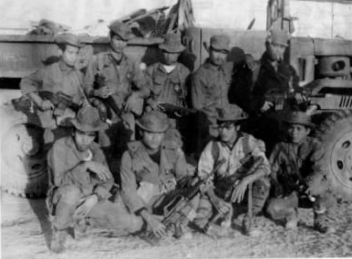
The indigenous members of MACV-SOG’s Spike Recon Team California at the Command and Control Central Forward Operations Base, 1969. The teams were designated by states, snakes, and various implements. They wear their team patch on their uniforms. These uniforms were not worn on missions. (Author’s collection)
B2: NCO, High Altitude–Low Opening Parachutist, 5th SFGA; Ft Bragg, NC, 1978
This jumper is equipped with the later MC-3 free-fall parachute assembly, which includes the military version of the sport Para-Commander Mark I canopy (pictured in the background). This is a highly manoeuvrable 24 ft canopy, available in olive green or a camouflage pattern. The reserve parachute is an olive green flat circular non-steerable canopy. The rucksack, a large LC-1 ALICE (Advanced Lightweight Individual Carrying Equipment) with an LC-1 frame, is strapped behind the jumper, rather than on the front as in the case of static line jumpers, to allow a more stable free-fall position. Additional team equipment can be dropped in a free-fall bundle with its own parachute and automatic opener. Free-fall jumpers usually manually deploy their parachutes at 2,000 feet; an altimeter is used to determine this altitude. As a back-up the FF-2 automatic ripcord release assembly is used. This soldier carries an M16A1 rifle.
He is wearing a more practical uniform for a mission: camouflage jungle fatigues, probably with long underwear and a field jacket liner underneath to protect him from the cold at high altitudes. Introduced in 1967, this was seldom used by SF in Vietnam, but was extensively worn by ‘Stateside’ SF units from the early 1970s. He wears the patch of his former Vietnam combat unit on his right shoulder: the 173rd Airborne Brigade.
A further refinement of HALO is the High Altitude–High Opening (HAHO) concept. This involves leaving the aircraft at a very high altitude and opening shortly thereafter. The jumper will then ‘fly’ his high-performance, ram-air canopy over a considerable distance before selecting his landing site. This allows the aircraft to ‘stand off’ a safe distance from the area of operations. This technique began to be developed in 1977 during the Off-Set Parachuting Techniques Concept Evaluation Program. A new system known as the Special Operations Advanced Parachute System (SOAPS) is currently under development.
B3: NCO, Parachutist Rough Terrain System, US Army Institute for Military Assistance; Ft Bragg, NC, 1982
The ability of an A Team to parachute into an area considered to be unfavourable for parachute insertion is highly desirable, but somewhat risky. For years SF has used techniques and equipment developed by US Forest Service ‘smoke jumpers’ for this purpose. This includes the use of penetration suits, and the conduct of rough terrain parachuting courses for landing in heavily wooded, rocky or mountainous areas. The old two-piece penetration suits were of heavy olive green cotton canvas (although white and orange ones have been used in training) with padding at the knees and elbows. There was a leg-bag on the right leg containing a 50 ft lowering rope. A football helmet with a wire mesh faceguard was used. In 1981 the requirement for a new suit was established. This was designated the Parachutist Rough Terrain System (PRTS), and is a one-piece suit made of heavy olive green nylon with pads protecting the neck, armpits, kidneys, elbows, crotch, and knees. A motorcycletype helmet with a clear plastic face shield is included. Test helmets are white, but once adopted, olive green ones will be issued. The issue of suits in camouflage fabric is also being considered. The suit contains an internal harness to which a leg-bag stowed lowering line system is attached. It is expected to be issued in 1986. An M1950 weapons container is attached to the jumper’s parachute harness.
C1: PFC, Student, SF Training Group; Simmons Army Air Field, Ft Bragg, NC, 1968
This SF Student is prepared to jump from a C-119 transport into Camp Mackall for his Phase I Field Training Exercise. He wears cotton fatigues with full-colour insignia: subdued insignia were not introduced until late that year. This was also before the rocker was added to PFC stripes. The trousers are a popular commercial version available in Post Exchanges and referred to as ‘ranger’ trousers due to the addition of the leg cargo pockets. On his M1 helmet is the old leaf pattern camouflage cover. On the reverse side of the cover is a spotted camouflage pattern of four shades of brown. The rucksack is the nylon, aluminium frame jungle model, which is attached to the jumper upside down. It was extensively used by SF units in the USA, but seldom in Vietnam, as its design limited the number of items that could be attached to the utility belt. About 200 ft above ground the jumper will release the rucksack which will drop below him secured by a 15 ft lowering line; this prevents injury from the heavy rucksack on landing. His weapon is an M14, 7.62 mm NATO rifle. M16A1s were available, but M14s were heavier, so they were issued to students. The main parachute is a static-line-deployed T-10 consisting of an olive green 35 ft parabolic circular non-steerable canopy. The reserve is a white 24 ft flat circular non-steerable canopy.
C2: PFC, Student, US Army Institute for Military Assistance Student Battalion; Pope Air Force Base, NC, 1983
Today’s SF Student, prepared for his Phase I ordeal at Camp Mackall; his jump aircraft will be a C-130. He is clothed in the new woodland pattern Battle Dress Uniform (BDU)—see Plate J1. A matching, non-reversible camouflage helmet cover is now issued. The rucksack is the large LC-1 ALICE pack with the later LC-2 frame. Load bearing equipment (LBE) is a mixture of the new nylon ALICE and cotton canvas M1956 gear. His weapon is an M16A1 rifle in an M1950 weapons container. The main parachute is an MC1-1/B, an olive green 35 ft parabolic circular steerable canopy (pictured in the background). The reserve is now olive green. Both the main and reserve parachute containers are now of nylon rather than the cotton canvas used for the T-10. This system also features a greatly improved harness.
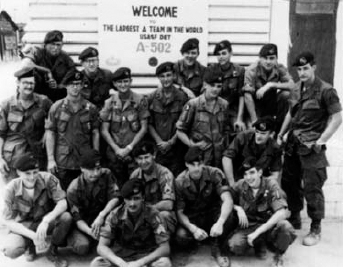
Part of Detachment A-502, Co. E, 5th SFGA, an augmented A Team under the Nha Trang Installation Defense Command, late 1969. It operated a half-dozen defensive camps located in a belt around Nha Trang, the 5th SFGA’s operations base. (US Army)
C3: CTU-2/A High Speed Aerial Delivery Container
The CTU-2/A was developed in the late 1970s to provide a means of resupplying A Teams from high speed aircraft. It was an outgrowth of a technique developed in Vietnam, where napalm bomb containers filled with supplies were dropped from fighter aircraft to resupply Mobile Guerrilla Forces and other special operations elements. It can be dropped from jet fighters flying at up to 425 knots from as low as 300 feet. It weighs only 213 lbs and can be loaded with up to 500 lbs of supplies and equipment. Measuring 21 ins. in diameter and 106 ins. long, it is parachute-retarded and re-usable—although, being made of fibreglass and acrylic resin, it can be burned after delivery. The parachute is a white 34 ft ringslot drag canopy. It is shown exposed here, but is normally covered by a tailcone.
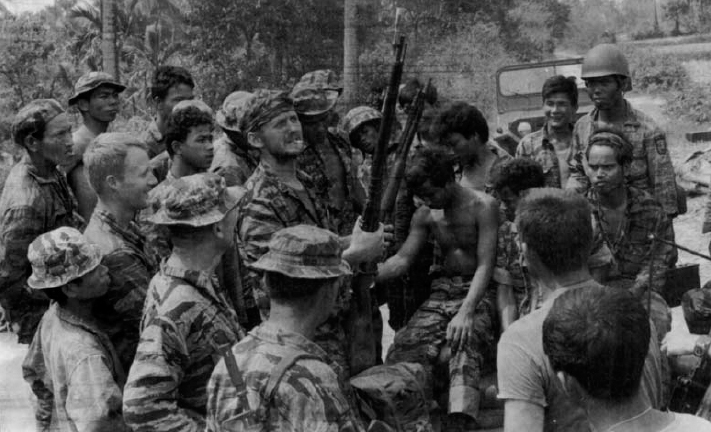
SF NCOs and Montagnard Strikers of the 5th Mobile Strike Force, late 1960s. The Americans tended to ‘go native’ rather quickly once in the field. Captured weapons are being presented to the Americans. (US Army)
D1: Corporal, Weapons Specialist, 77th SFGA; Uwharrie National Forest, NC, 1955
This weapons specialist is presenting a class to ‘guerrillas’ on the Soviet PPSh-41 sub-machine gun. During this period the 77th was wearing a Canadian-made beret. He wears the herringbone fatigue uniform with an M1953 field jacket. In 1955 the World War II rank chevrons (previously worn until 1948) replaced the small and unpopular gold-yellow and dark blue chevrons.
D2: Sergeant, Demolitions Specialist, 6th SFGA; Ft Greely, AK, 1970
Rappelling is a basic skill for SF troopers. This man wears a wool shirt with field trousers, the trouser counterpart of the field jacket. Climbing boots (usually referred to as ‘Chippewas’ after the manufacturer), the M1951 field cap (commonly referred to as the patrol cap), and work gloves complete the outfit. Slung over his shoulders are an M14 rifle (not standard issue, but sometimes used in exercises) and a non-electric demolitions kit.

Task Force Ivory Coast’s Assault Group on a C-130 transport en route between Takhli and Udorn Royal Thai Air Force Bases, 21 November 1970. At Udorn they transloaded to HH-53 helicopters and departed for Son Tay, North Vietnam. The ‘criss-crossed’ box in the centre is the demolition charge used to breach the prison’s wall.
D3: 1st Lieutenant, A Detachment Executive Officer, 11th SFGA; Camp Drum, NY, 1972
Operating the team’s G-13 hand-cranked generator is one of the less popular chores that members are called upon to perform; it is a standing joke within SF that this is one of the principal duties of the A Team XO. He wears an olive green cold weather parka and field trousers under a two-piece overwhite camouflage suit. The parka has a detachable fur-ruffed hood. The cold weather insulated cap is designed to be worn under the helmet; a woodland camouflage version was introduced in 1983. Three-finger mittens, often referred to as ‘triggerfinger’ mittens, and rubber insulated boots complete the outfit. The boots are also made in black; known as ‘Mickey Mouse’ or ‘VB’ (vapor barrier) boots, they are extremely warm—sometimes too warm, as they are completely airtight. For this reason there is an air release valve on the side to allow for equalisation of pressure when in an aircraft.
E1: NCO, Weapons Specialist, Camp Strike Force, 5th SFGA; Vietnam, 1969
This member of an A Detachment is wearing the later pattern tiger-stripe uniform with a locally purchased jungle hat. The not-too-popular blue and green striped scarf was worn by some members of Co. A, 5th SFGA. It was extremely rare for any insignia to be worn on these uniforms—primarily for security reasons, but also because they only lasted for a few operations. His M16A1 rifle has camouflage tape applied. The LBE is all M1956 cotton canvas equipment. The ammo pouches were designed to hold two M14 magazines, but they could hold four 20-round M16A1 magazines also. Since these magazines were shorter, additional field dressings were often placed in the bottoms to raise the magazines up. One of his four ammo pouches contains such items as a penflare projector, signal mirror, and small marker panel, all used to mark his unit’s position for aircraft. The first aid pouch on his suspenders contains a lensatic compass. The indigenous rucksack is being carried (see also under Plate F2). Jungle boots were first issued in 1965.
E2: CIDG Striker, Company 331; Chi Linh Camp Strike Force, III Corps Tactical Zone, Vietnam, 1969
This Striker wears an older version of the tiger-stripes than E1. These are faded, but were originally a lighter shade to begin with. His jungle hat is standard indigenous issue, but has the brim cut down by the camp tailor, a common practice. His boots are the later black canvas, rubber soled ‘Bata’ boots manufactured by Bata Footwear of Canada. Some CIDG managed to acquire US-made, Asian size jungle and all-leather combat boots. The company scarf, originally red, white and blue, has faded with washing. The CIDG Camp Strike Force patch, authorised in 1968, was normally worn on the left shoulder, but Co. 331 wore it on a red patch on the chest pocket. He wears M1956 LBE and carries an ARVN rucksack. This latter item was not too popular as it soaked up water, becoming heavier, and its top flap securing straps ran over the top where they often snagged on branches. It was tolerated, though, because of its larger load capacity than the indigenous rucksack. The M2 carbine, .30cal., capable of both semi- and fully-automatic fire, was the principal weapon of the Camp Strike Forces (along with a few M1 rifles, M1918A2 Browning Automatic Rifles, and M79 40mm grenade launchers) until they were replaced en masse by the M16A1 rifle in the spring of 1969.
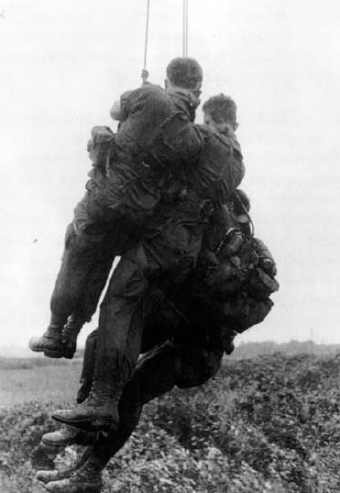
A helicopter extraction using the McGuire rig, predecessor of the STABO system, here employed by members of the 46th SF Company, Thailand, 1971. Lift-off had to be slow to prevent the troops from being slammed into each other as they came off the ground. (S. L. Stanton)
E3: Staff Sergeant, Medical Specialist, Camp Strike Force, 5th SFGA; Vietnam, 1967
Except when actually conducting operations, when tiger-stripes were worn, SF troopers normally wore the standard jungle fatigues. All authorised insignia were worn on these uniforms. Even after 1968, when subdued insignia were introduced, full-colour embroidered insignia were often seen. Worn over the right pocket are Vietnamese Special Forces (VNSF) jumpwings. Shown here are the more common Vietnamese pattern, but wings embroidered in US style were sometimes worn. VNSF jumpwings were awarded honorarily to USSF troopers, and US jumpwings were likewise awarded to VNSF personnel. Over his US jumpwings he wears the combat medic badge. All other team members were eligible for the combat infantryman’s badge after serving at least 30 days as an advisor and being involved in at least two offensive ground actions. On his left pocket is worn the VNSF patch to signify his advisory rôle: A Teams assigned to Camp Strike Forces, B and C Teams, and Group Headquarters personnel all wore this patch. Those assigned to Mobile Strike Forces and reconnaissance projects did not. (USSF officers wore the Vietnamese equivalent of their rank between the second and third buttons on the front opening of the shirt.) This medic—commonly referred to as ’Bac Si’, Vietnamese for ‘doctor’, by both the indigenous troops and fellow team members—is on a MEDCAP (medical, civic action programme) mission at a village near his camp. These areas were normally fairly secure and for this reason he is armed with only a .45cal. M1911A1 pistol in an M1916 holster. Another reason for the pistol is that it was regarded as a sign of authority by the Vietnamese and was often worn when dealing with them.
F1: Sergeant First Class, 3rd Mobile Strike Force, Detachment A-302, 5th SFGA; Vietnam, 1966
This NCO, assigned directly to a Mike Force Company, is wearing an early pattern of the tiger-stripes, which began to be issued in the early 1960s. The small ‘cigarette’ pocket on the trousers, and also found on some shirt sleeves, was in fact intended for field dressings. His jungle boots are the early version without the reinforcing straps at the ankles. He wears a red, white and blue scarf, popular with many Mike Force units. In some Mike Forces different coloured scarves—e.g. bright green—were presented as unit level awards to individuals. On his shoulder he wears the old Mike Force patch. It was banned from wear by non-SF higher headquarters, as the skull and crossbones did not fit the image desired for Free World forces; and it was felt that the meaning of ‘M.F.’ might be misinterpreted. . . . It was officially replaced in 1968 by a patch similar to the one worn by E2, but with a black parachute behind the tiger’s head. He is armed with the older M16 rifle with the prong-type flash-hider (which caught on branches) and did not have a bolt assist assembly on the right side. On his M1956 LBE are M26 fragmentation and M18 coloured smoke grenades, the latter available in yellow, red, green, and violet.
F2: Specialist Five, 2nd Mobile Strike Force Command, Detachment B-20, 5th SFGA; Vietnam, 1969
This man characterises the enlargement and general upgrading of Mike Forces in 1968–69. He wears the newer style US size tiger-stripes which actually fitted Americans—who usually had to make do with ‘large’ Asian uniform sizes. On his pocket he wears the 2nd Mike Force patch; this was normally worn by the strikers, but some USSF also wore it. 2nd Mike Force USSF personnel had their own elaborate ‘dragon’ pocket patch, but these were not worn in the field. The standard helmet, with a Republic of Korea Army camouflage cover, is being worn due to the more conventional nature of their operations. His jungle boots have the ‘Panama’ soles, named for the area where they were developed; the cleated sole was designed to reduce mud build-up. The indigenous rucksack appeared in the early 1960s, and was modelled on the NVA version because of its practical design, ease of manufacture, and the fact that from a distance it would assist the wearer to appear as an NVA or VC. Most were made of a water repellent greyish green fabric, but olive green canvas ones were also made. His LBE is an M1937 Browning Automatic Rifle (BAR) belt. It has six pockets, each intended for two 20-round BAR magazines, but in this case four 20-round XM177E2/M16A1 magazines are carried. The belt was a popular, but somewhat scarce item. It did have the disadvantage that M1956 LBE items could not be attached to it; this trooper probably went to great lengths to scrounge an M1936 canteen carrier and M1942 first aid pouch. On his left hand M1956 suspender is attached an SDU-5/E strobe light (one of several models) in a nylon case; its beam can be seen from up to ten miles from an aircraft, and will not destroy night vision. They were generally equipped with a flash guard (to prevent detection from the ground) and a blue filter (so that the aircrew would not mistake it for a muzzle flash); an infrared filter was also available. His weapon is the XM177E2 sub-machine gun, a lightweight version of the M16A1 with a telescoping stock. Usually referred to as the CAR-15 (Colt Automatic Rifle), it was extensively used by Mike Force and reconnaissance project personnel. An M33 ‘baseball’ fragmentation grenade, greatly improved over the old M26, is also carried.
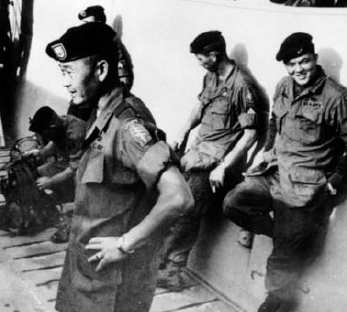
Members of the 1st SFGA on a Navy landing craft, 1969. A mix of full-colour and subdued insignia were often worn during the change-over period. (US Army)
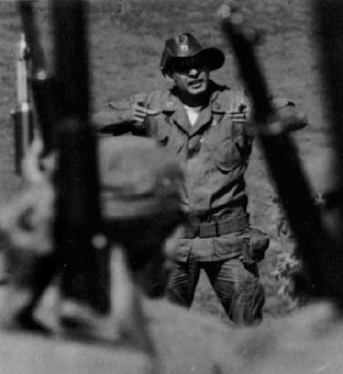
An 8th SFGA mobile training team member instructs recruits of the El Salvadorian Army at its Sonbonate Recruit Training Center, September 1971. (US Army)
F3: CIDG Striker, Plei Mrong Camp Strike Force; I Corps Tactical Zone, Vietnam, 1964
The spotted pattern camouflage uniform was used from the late 1950s until fully replaced by tiger-stripes in the mid-1960s; it proved to be rather ineffective, as it was not green enough for Vietnam’s lush jungles, and its light colour was conspicuous. Olive green and black uniforms of a similar design were also worn by the early Strike Forces. The caps, too, were available in those colours as well as in tiger-striped pattern. His boots are the early olive green canvas, rubber soled ‘Bata’ pattern, often referred to as ‘tennie’ boots. The scarf is worn for ‘friend-or-foe’ identification; red ones were also worn as a deception measure, as many VC units wore them. His LBE is a World War II issue M1936 pistol belt with 15-round carbine magazine pouches (each holding two), M1936 canteen carrier, and the ‘X’ back M1945 suspenders. He is armed with an M1 carbine, capable of semi-automatic fire only. Other weapons issued to the early Strike Forces included M1903A3 bolt-action rifles, .30cal.; M3A1 sub-machine guns, .45cal.; and even some former German World War II MP40 sub-machine guns, 9 mm.
G1: NCO, Reconnaissance Team Leader, Military Assistance Command Vietnam—Studies and Observation Group
This is a composite picture of a typical USSF Reconnaissance Team (RT) member. During the eight years that MACV-SOG existed, widely varying mission uniforms and combinations of equipment were employed: they changed with time, experience, the requirements of the mission, and other circumstances. The uniform pictured is jungle fatigues with black disruptive splotches spray-painted on. Although only used to a limited extent, it proved to be very effective in jungle shadows and at night. LBE items were similarly camouflaged. Olive green and camouflage jungle fatigues, jungle fatigues dyed all black, and the various patterns of tiger-stripes were also used. Olive green jungle fatigues were the most common, as the dark green colour had the appearance of an NVA uniform from a distance. Uniforms were sometimes soaked in insect repellent and air-dried before a mission. All manner of headgear was worn, including cut-down jungle hats and headbands made from issue triangular bandages, the latter being common, again due to their deceptive appearance. This man wears a black hat, as it was the ‘VC colour of the day’, a ploy used in their attempts to detect RTs. Jungle boots were the most common footwear, but efforts were sometimes made to leave deceptive footprints by wearing ‘Ho Chi Minh’ sandals, grinding the cleats off boot soles, wrapping boots with rags, or pulling thick socks over them. The US Army’s Natick Laboratory even provided, on a test basis, a limited number of modified jungle boots with soles duplicating indigenous bare feet and sandals. M1938 canvas leggings were worn by some teams, as here, in an effort to keep out leeches. No insignia of any kind were worn, though most RTs did have their own unauthorised patches. They were sometimes sewn to the inside lining of USSF members’ berets, while indigenous members wore them as pocket patches when in their Forward Operations Base.
All manner of LBE was also worn, although M1956 gear was the most common. STABO extraction harnesses were also used extensively (see Plate H1). The M1937 BAR belt was also popular due to its large capacity for magazines. Canteen carriers were often used to carry 30-round XM177E2/M16A1 magazines, as no standard pouch was issued for them until after the war. Another popular item were survival vests intended for aircrews, such as the SRU-21/P pictured here: Army olive green and Air Force sage green ones were both used. They had up to a dozen pockets, ideal for carrying the many required air-to-ground signal devices and survival items. A knife scabbard and pistol holster could also be attached to them.
A wide variety of weapons were also employed, including the XM177E2 sub-machine gun (by far the most common); M16A1 rifle; M79 grenade launcher; some Swedish-made M-45/b 9 mm submachine guns (often incorrectly called the Swedish ‘K’) in the early days; and in certain circumstances, enemy weapons such as the AK-47, or special purpose weapons such as silencers for pistols and rifles, and night vision sights (starlight scopes). Handguns of various models were also carried, with issue M1911A1 .45cal. and FN-Browning ‘Hi-Power’ 9 mm pistols (originally purchased by the CIA) the most common due to their availability. Various types of hand grenades were carried for the purpose of breaking contact with enemy forces; this man carries an M34 white phosphorus smoke grenade, which has both a fragmentation and an incendiary effect as well as an extensive smoke cloud. A few teams even carried a 60 mm M19 hand-held mortar for breaking contact. This trooper carries a privately owned Gerber Mk. II fighting knife; the various models of Randall combat knives were also popular.
G2: NCO, Assistant Reconnaissance Team Leader, Project Delta, Detachment B-52, 5th SFGA; Vietnam, 1964
Project Delta, like the other ‘Greek-letter’ reconnaissance projects, utilised various uniforms, equipment, and weapons throughout its six year existence. Tiger-stripes were the usual uniform for these projects. The cut-down-brim jungle hat was greatly favoured by Delta, but headbands made from triangular bandages were also popular, especially if the individual did not have to be concerned with concealing light coloured hair. LBE was the usual M1956 gear with a lot of canteens: water was a constant problem for the RTs, as the enemy often patrolled along streams to limit their use by the teams as well as to detect signs of their presence. Collapsible two-quart canteens were popular for this reason. A can of serum albumin is taped to the suspenders yoke: this is a blood volume expander used to restore and maintain the blood pressure of severely wounded until they could be evacuated. Issue gloves with the finger tips cut off were effective in protecting the hands from thorns and vines, but allowed unhampered use of weapons. A compass was carried in the chest pocket and secured by a cord around the neck. In his indigenous rucksack this man carries an AN/PRC-25 radio for contact with his patrol base, forward air control and extraction aircraft. Both USSF members of an RT carried such a radio, along with an AN/URC-10A emergency air-to-ground radio. Delta initially used M16 rifles, but were later equipped with the XM177E2 sub-machine gun. A cut-down 40 mm M79 grenade launcher was carried by some RTs as a break-contact weapon.
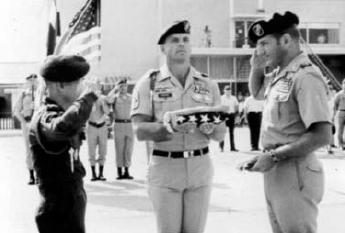
The commander and sergeant major of the 46th SF Co. receive a unit award from the Deputy Commander of the Royal Thai Army Special Warfare School at Lopburi, Thailand, 1972. The USSF wear the Army Tan uniform. (US Army)
G3: CIDG Mountain Scout; Plei Yt Commando Training Center, I Corps Tactical Zone, Vietnam, 1963
The Plei Yt Commando Training Center was operated by Detachment A-751, US Army Special Forces, Vietnam. Black uniforms were normally issued to these troops, while olive green and spotted camouflage ones were the normal issue to Strike Force companies. Headgear varied greatly and included various colour and camouflage pattern jungle hats and caps, and brown berets. LBE was minimal and usually consisted of World War II gear. The M3A1 sub-machine gun, .45cal., commonly referred to as the ‘grease gun’, was standard issue for Strike Force Reconnaissance Platoons at this time; flash-hiders were almost universal issue.
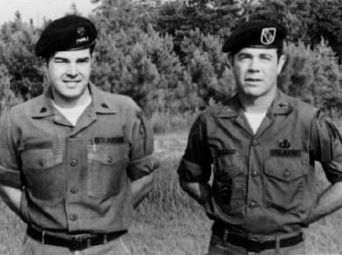
The 5th SFGA chaplain and his assistant at Ft Bragg, mid-1970s. The chaplain wears a Ranger tab and Jungle Expert patch on his OG 507 ‘wash-and-wear’ fatigues. The assistant wears a ‘candy stripe’ cut from a full-flash, as manufactured ones were not then available. His fatigues are the cotton OG 107 model. (US Army)
H1: Staff Sergeant, Ranger Instructor, Detachment A-41, 46th SF Company; Thailand, 1972
Detachment A-41 (Ranger) was responsible for instructing the Royal Thai Army (RTA) Ranger School, a component of the RTA Special Warfare Center. All of the team’s personnel were Ranger-qualified; many of the NCOs had been instructors in the US Army Ranger Department, and were directly reassigned to A-41. The team was additionally tasked with clandestine missions in Laos and Cambodia. Olive green jungle fatigues were the authorised uniform, but often, for instructor duties and while conducting operations with Thai Rangers, its members wore standard-issue black Thai Ranger fatigues. These were not merely dyed jungle fatigues, but Thai-made with black fabric. Worn with this uniform was a black beret with the 46th SF Company flash topped by a Ranger tab. A green beret was still the standard headgear with other uniforms. The Thai-made US badges and insignia were embroidered black on either an olive green or black backing and were often intermixed. On his right shoulder this NCO wears an unauthorised combat patch (i.e. that of his former unit)—Deputy Chief, Joint US Military Assistance Group, which was the cover designation for US advisors inside Laos. The SF patch and Ranger tab would be on his left shoulder. On his right chest pocket he wears a badge denoting service with the Royal Palace Guards. Over the right pocket are Thai jumpwings. These insignia were only worn for instructor and training duties, and not on combat operations.
The LBE is made up of a combination of items. It includes a nylon Modernized Load Bearing Equipment (MLBE) utility belt with a quick-release buckle (which was not too popular, as it often came unfastened at the wrong times); Laotian issue M16 ammo pouches, originally made by the CIA as sterile equipment and subsequently adopted by the Laotian Army; and a STABO extraction harness in lieu of normal LBE suspenders. The MLBE system consisted of all nylon items and was basically an interim system introduced in 1967 prior to the adoption of the ALICE system.
The STABO extraction system was developed by SF instructors at the MACV Recondo School: STABO is the combined initials of the five NCOs who developed it. The system was intended to be an improved and safer replacement for the earlier McGuire, Hanson, and Palmer rigs, also developed by SF NCOs. The STABO harness is normally worn with the leg straps unfastened and rolled up, secured to the back of the utility belt. The system is intended to extract from one to four men from a site where a helicopter cannot land. The necessary number of 147 ft ropes are dropped in deployment bags to the ground party. They attach the web bridle to their harnesses, and the chopper lifts them out. They cannot be hoisted into the aircraft with this system, but are flown, suspended under the aircraft, to an area where a safe landing is possible. Here they are lowered to the ground, the helicopter sets down, and the personnel board it.
This soldier has a strobe light and the excellent Air Force survival knife attached to the STABO harness. The Thai ceremonial dagger was not just for show: it was recognised as a sign of authority by Thais, and was in fact issued to SF personnel involved in advisory duties. He is armed with an M16A1 rifle.
H2: 1st Lieutenant, Executive Officer, Detachment A-45, 46th SF Company; Thailand, 1972
Detachment A-45 (Special Missions), like A-42, was a team directly under the control of 46th Company Commander and used for special assignments such as Operation ‘Freedom Runner’; these were operations conducted with the Cambodian SF. These two teams also conducted special reconnaissance missions in support of the RTA 2nd and 1st SF Groups respectively. Other teams directly under 46th Company Commander’s control were: A-41 (Ranger), A-43 (SCUBA), and A-44 (HALO).
The lieutenant wears the standard RTA SF camouflage fatigues, which were popular among USSF personnel in the 46th Company. Over his right chest pocket he wears Cambodian jumpwings. On the left pocket flap is the ‘Special Unit’ tag worn by all organisations which supported the RTA Special Warfare Center. Another unauthorised combat patch is worn on his right shoulder: one of several designs worn by the Military Equipment Delivery Team, Cambodia (MEDTEC). These insignia were worn only while conducting advisory and training duties and not on active missions. The lieutenant’s bar and infantry crossed rifles are worn horizontally and parallel with the lower edge of the collar, which was Thai practice, and one of the hazards of using local tailors. His LBE is the MLBE system, with the addition of a STABO harness. He is armed with an XM177E2 sub-machine gun. On the ground is a forest penetrator. This device is used on rescue hoist equipped helicopters. It has a weighted nose and folding blade seats that allow it to penetrate through interlaced tree branches. One to three men can be hoisted into the helicopter on the penetrator, which has safety straps that allow the individuals to be secured to the seat during hoisting.
H3: Surface-To-Air Recovery System
The Fulton Surface-To-Air Recovery (STAR) system was developed jointly in the early 1960s by the Army and Air Force under Project ‘Sky Hook’. It provides a means of recovering personnel or equipment with long-range transport aircraft from areas that are out of range of helicopters. The Fulton system is fitted to some MC-130H Combat Talon Blackbird special mission aircraft operated by USAF Special Operations Squadrons, and was also fitted to some CV-2B Caribou aircraft of SFGA Aviation Companies. The STAR kit can be delivered to the recovery site by a cargo parachute dropped from the recovery aircraft itself or in a CTU-2/A aerial delivery container (see Plate C3) from a fighter aircraft. Kits can also be rigged in waterproof containers, with a rubber raft included, for water drops and recovery.
The STAR kit consists of two air-droppable bags containing a cartoon instruction board; an 8 ft diameter, 23 ft long balloon; one of two strengths of 500 ft long nylon lift lines intended for either one or two men, or 250 or 500 lbs of equipment/materials respectively; two helium bottles; an insulated nylon coverall suit with an internal harness; marker flags, for day use, and strobe lights for night use; and a remote control device to turn on the strobe lights (the aircraft also has a light-activation device, but it seldom works).
To accomplish pick-up a recovery zone of only 100 ft in diameter is required. Obstacles outside of this circle can be up to 50 ft in height. The individual to be recovered is suited up, attached to the lift line, and sits on the ground facing in the direction from which the aircraft will approach. The balloon is then inflated and released. The recovery aircraft approaches the balloon, into the wind, with its lift line yoke arms extended. It snags the line in a locking device on the nose, and the balloon’s breakaway extension cords detach themselves. There are cable fendlines running from the base of the yoke arms to the wingtips to prevent the lift line from fouling the props in the event of a miss. The individual is lifted off the ground (rather slowly at first), and is towed behind the aircraft until the line becomes parallel to its belly. A cable with a hook, attached to a powered winch, is lowered to retrieve the lift line, and pulls it and the individual into the rear ramp door. Since this system’s introduction in 1964 there have been over 200 live extractions with only one fatal lift line failure.
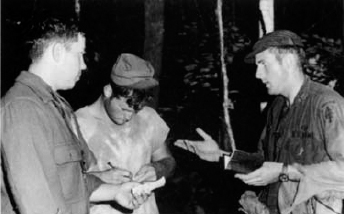
A student A Team commander briefs team members during their Phase III unconventional warfare exercise in Uwharrie National Forest, North Carolina, late 1970s. The centre man is dressed to blend in with the ‘guerrillas’. (US Army)
I1: Sergeant First Class, Task Force Ivory Coast; Son Tay Prison, North Vietnam, 1970
The raid on the Son Tay Prison on 21 November 1970 was probably one of the most expertly executed rescue missions in modern history; tragically, however, it proved a ‘dry hole’. The 65 American prisoners of war being held there had been moved to other prisons shortly before the raid. The Army element of Task Force Ivory Coast were SF troopers selected from the 6th and 7th SFGAs and commanded by Col. Arthur ‘Bull’ Simons. They were inserted into the prison compound and surrounding area by Air Force HH-3 and HH-53 helicopters flown by Air Rescue and Recovery Service crews. The soldier portrayed here is not a specific individual taking part in the raid, but rather a composite example.
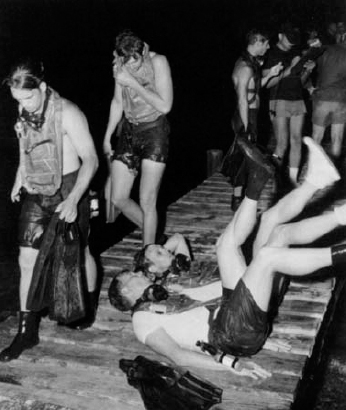
Students of the SF Underwater Operations (SCUBA) Course, Key West, Florida. They have just completed their long-distance night qualification swim. (US Army)
A good deal of leeway was allowed in how the raiders configured their individual equipment. Their individual duty requirements also dictated this. Standard M1956 LBE was used as the basis for individual equipment. Canteen carriers were used to carry the XM177E2 30-round magazines, as no issue carriers had been adopted at this time. Taped to his left suspender strap is a miner’s lamp and below it is a strobe light pouch. On the right suspender strap is an AN/PRT-4A radio transmitter (no receiver was carried, as he had only to report when he was in position). He has standard issue goggles with the addition of red press-on film to protect him from the air-dropped illumination flares. To protect his hands, but allow him to feel for locks and operate his weapons without the restrictions imposed by most gloves, he wears thin Air Force summer-weight flying gloves. Olive green jungle fatigues bearing rank insignia only were worn by all raiders. The XM177E2 sub-machine gun was carried by most of the 52 raiders. A commercial Armalite Singlepoint Nite Sight was fitted to each and reinforced with tape. Other armament carried by the force included M60 machine guns, M79 grenade launchers, M16A1 rifles, and 12-gauge riot shotguns. In addition, most carried an M1911A1 pistol and several hand grenades; most of these were Mk. III offensive grenades, commonly referred to as concussion grenades, due to their heavy blast effect with little fragmentation. Numerous items of survival and distress equipment were carried by all members. The patch is one that the raiders had made in Thailand before returning to the States; it was not worn on uniforms, but was a commemorative memento. The lettering stands for: ‘Kept in Total Darkness/Fed Only Horse Shit’.
I2: NCO, Delta Force Operator; ‘Desert One’ Base, Iran, 1980
Delta Force’s uniform during the ill-fated hostage rescue attempt was quite different from the usual standards of military dress. This was due to the unit’s unique mission requirements and the need to blend into the population, at least from a distance. The ‘uniform’ consisted of an M1965 field jacket(worn by many Iranian students and ‘Revolutionary Guards’), dyed black; a dark coloured civilian shirt; blue jeans; wool navy watch cap; and some type of black boots. Issue combat boots were common, but ‘Chippewa’ climbing boots were favoured by many. On the jacket sleeve was a tape-covered American flag: the tape was to have been removed when the force reached the US Embassy in Tehran the following night. He is armed with a 9 mm West German-made HK5A2 sub-machine gun; telescoping-stock HK5A3s were also used. Other operators carried XM177E2 and M3A1 submachine guns, M16A1 rifles, and accurised M1911A1 pistols. The force was also armed with an M60 and an HK21 light machine gun, 7.62 mm, and a few M79 and M203 grenade launchers. LBE was not carried, as it would have made it too easy to spot an operator; extra magazines and evasion, escape and survival items were carried in the pockets and sewn into the field jacket.
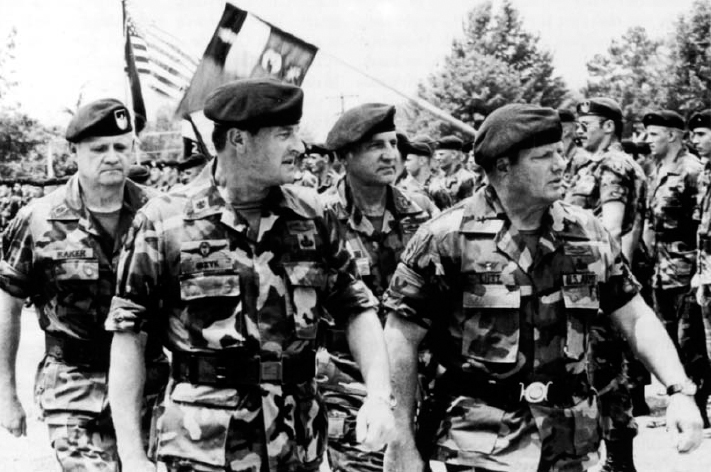
The staff of the Institute for Military Assistance inspect the Student Battalion, July 1983. The guidon of the 3rd Student Co. is seen in the background. (US Army)
I3: NCO, SCUBA Diver, 8th SFGA; Panama, 1972
SCUBA (Self Contained Underwater Breathing Apparatus) operations as conducted by Special Forces units are primarily intended for infiltration into enemy-held areas. Underwater reconnaissance, rescue, and recovery operations, as well as some offensive missions, are also conducted. The Special Warfare Center has conducted a SCUBA course for years at Key West, Florida. Groups maintain some A Teams that are fully SCUBA-qualified. Besides normal SCUBA operations, such techniques as surface scout swimming and para-SCUBA are also practised. Standard sport and commercial-type SCUBA equipment is used on most operations, but there is a very specialised piece of equipment available. This is the CCR-1000 closed-circuit rebreathing system, which re-cycles oxygen so that no exhaust bubbles can be seen on the surface. Other diving equipment includes the navy SCUBA buoyancy compensator (which can be used as a flotation vest, but its principal purpose is to allow the diver to achieve neutral buoyancy once he reaches his planned operating depth); weight belt; M3 combat knife; Mk. 13 smoke and illumination signal (one end burns orange smoke for day use and the other is a red flare for night use); depth gauge; compass, and dive watch. Items that require to be individually fitted, such as mask, snorkel and fins, are purchased by the individuals from sport diving shops. He has just completed reassembly of the M79 grenade launcher which he carried in the waterproof equipment container.
J1: Staff Sergeant, A Detachment Radio Operator, 10th SFGA; Ft Devens, Massachusetts, 1983
The Battle Dress Uniform (BDU) was first issued in 1982. Its design is based on the jungle fatigues, but several of the more practical design features were not included, thus detracting from its value as a field uniform. It is infrared-absorbent, which gives it some protection from certain night vision devices. The BDU’s thick 50 per cent cotton/50 per cent nylon fabric also proved to be too heavy for year-round wear. This became readily apparent during the 1983 Grenada invasion, when an emergency issue of jungle fatigues was made to some units. The Army will reintroduce the design improvements as well as issue a lightweight tropical/summer version in 1985: these will be basically the old jungle fatigues with the addition of the woodland camouflage pattern, On this NCO’s left pocket flap is a SCUBA diver badge. Above his right pocket he wears West German jumpwings, which are available in US style embroidery and colours.
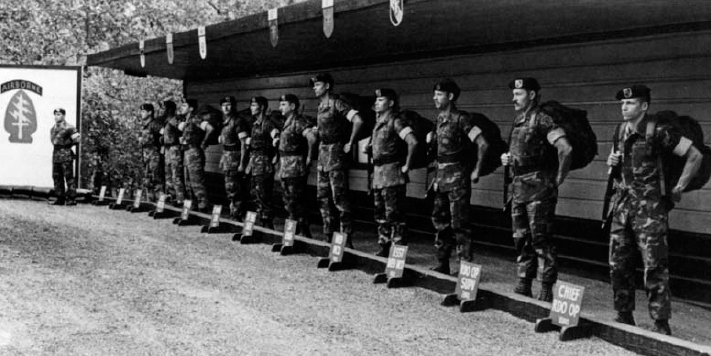
An A Team of the 5th SFGA at the Gabriel Demonstration Area, mid-1970s. They are clothed in the camouflaged jungle fatigues. (US Army)
His LBE consists of ALICE equipment to include M16A1 30-round magazine pouches. The rucksack is the large LC-1 ALICE model, on which is an M16A1 rifle. The radio is the newly issued AN/PRC-70 with an OA-8990/P Digital Message Device Group (DMDG). The DMDG is a micro-computerised message device that will burst-transmit a message, which has been typed into it, in a matter of seconds rather than the many minutes required for manual Morse Code, thus making it very difficult for enemy radio direction finders to locate the transmitter. The DMDG coupled with the almost unlimited range of the AN/PRC-70 makes an excellent combination for the unique communications requirements of SF. This equipment replaces the older AN/PRC-74B radio and AN/GRA-71 coder-burst group.
J2: Major, B Detachment Commander, 5th SFGA; Exercise ‘Bright Star’, Egypt, 1982
The desert camouflage version of the BDU was developed in the late 1960s, but shelved as there was no pressing requirement for it at the time. It was introduced in 1982 for issue to units operating in desert areas. Units slated for Army Central Command (formerly Rapid Deployment Force—RDF) are among those issued with it due to their possible deployment to the Middle East. The uniform is of the same design and fabric as the BDUs. A wide-brimmed jungle-style hat of the same camouflage pattern is available, but a helmet cover is not; units usually fabricate some type of cover, using sand coloured cloth. A dark grey parka and overtrousers are also issued with this uniform for wear during the cold desert nights; they have a mesh-like dark green pattern printed on them, limiting the chance of detection by night vision devices.
This officer wears a Pathfinder badge below his master parachutist badge. He wears minimal ALICE equipment and is armed with an M1911A1 pistol; a lanyard is required during training exercises to prevent loss. The old M1923 cotton webbing pistol magazine pouch is still in use even though newer models have been issued.
J3: Sergeant Major, Staff NCO, 1st Special Operations Command; Ft Bragg, NC, 1984
The Army Green uniform was adopted in 1957 and has gone through a number of minor changes since. The grey-green shirt replaced the tan poplin model in 1976. The grey-green shirt, in conjunction with the Army Green trousers, may be worn without the coat. This uniform will replace the Army Khaki and Tan (tropical worsted) uniforms in 1985. Both long-and short-sleeve versions are available. ‘Corcoran’ jumpboots (a brand name that has become generic) are normal wear with service uniforms by all SF, Ranger, and other airborne units. Worn over the 1st Special Operations Command patch is the new SF qualification tab. The service stripes on the left sleeve each represent three years’ service. The ribbons on the left chest are all individual awards while those on the right, in gold frames, are unit awards. Vietnamese SF jumpwings are worn above these.
K: Beret Flashes
Flashes are used to identify the various SF units and organisations. Abbreviations used are: Bn. = Battalion, Co. = Company, Det. = Detachment, Abn. = Airborne.
K1: Reserve and National Guard SF Units. This flash was worn by the Reserve’s 2nd, 9th, 11th, 12th, 13th, 17th, and 24th SFGAs and 40th SF Det., and the National Guard’s 16th, 19th, 20th, and 21st SFGAs, from 1961 until they were inactivated or adopted their own flash in the late 1960s or early 1970s.
K2: 1st SFGA. This was the original flash worn by the 1st from 1961 until the black border was added.
K3: 1st SFGA. To mourn the death of President Kennedy in 1963, 1st SFGA members added a black border to the flash with felt-tip markers. This outer black border was made official on 5 March 1964. Due to the difficulty of seeing it against the dark green beret, it was soon changed to an inner border; this was not made official until 5 November 1973. ‘Candy stripes’ normally retained the outer black border.
K4: 3rd SFGA. Approved in December 1963, this flash’s colours represented the 1st, 5th, 7th, and SF Training Groups from which its personnel were drawn—and not the flags of Africa, as is sometimes reported. It was sometimes referred to as the ‘trash’ or ‘Purina Dog Chow’ flash.
K5: 5th SFGA. A solid black flash was originally envisioned in 1961, but a white border was added almost immediately for visibility against the beret. It was worn until K6 (below) was adopted.
K6: 5th SFGA. This flash was originally adopted by US Army Special Forces Vietnam (Provisional) in 1963. Its colours represented the 1st, 5th, and 7th SFGAs from which most of its elements were detached. The colours of the South Vietnamese flag are also depicted. Prior to the adoption of this flash the detachments wore those of their parent group. When the 5th SFGA deployed to Vietnam to assume the mission of SF Vietnam, the group requested that it be allowed to adopt this flash for tradition’s sake, but also because it was felt that if SF personnel began wearing the black and white flash, it would be misinterpreted by the Vietnamese as the eradication of their national colours from the flash rather than as a simple change of insignia to conform with unit reassignment. This became the official 5th SFGA flash in late 1964 and was retained after it returned to the States.
K7: 6th SFGA. This flash was approved in 1963. Its colours represented the 5th, 7th, and SF Training Groups which provided personnel for this group.
K8: 7th SFGA. This flash was originally approved in 1961. Flashes of red naugahyde have been used.
K9: 8th SFGA. This flash was adopted in 1963, using the traditional SF colours.
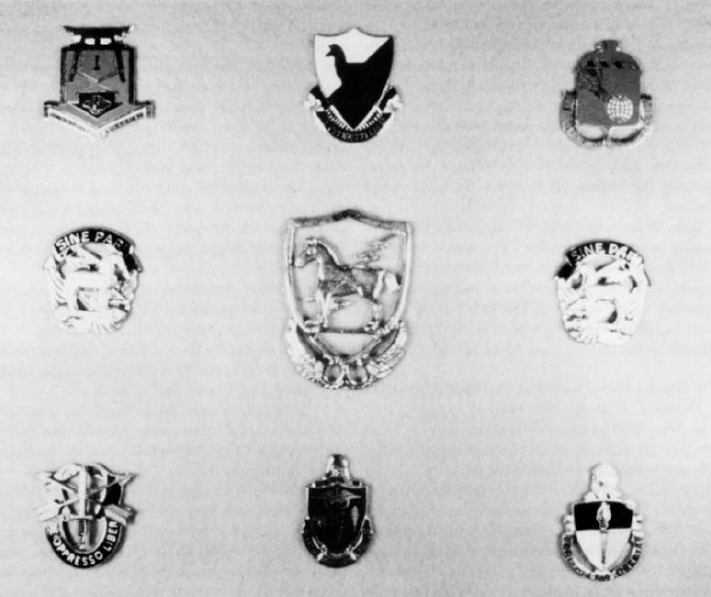
SF crests: (Top, L to R) 1st SFGA, late 1950s—’arrows’ are mid-and dark blue, background light green; 10th SFGA, late 1950s—background black and white; 77th SFGA, late 1950s—gold, black and white detail on teal blue.
(Centre) 1st Special Operations Command, right shoulder strap; 10th SFGA beret badge, 1955–62; 1st SOC, beret and left shoulder strap.
(Bottom) 1st Special Forces, since 1960; Walter Reed Army Institute of Research, worn by SF FEST—silver and maroon; Special Warfare Center and Institute for Military Assistance, since 1962—black and white background.
K10: 10th SFGA. This flash was approved in 1961.
K11: SF Det. (Abn.) Europe, and 1st Bn., 10th SFGA. This flash was originally approved for SF Det. Europe on 17 April 1969, utilising the German colours. In 1970 its wear was extended to Co. A, 10th SFGA which had remained in West Germany after the bulk of the unit returned to the States. In 1972 Co. A was redesignated 1st Bn., 10th SFGA. 39th SF Co. also wears this flash.
K12: 11th SFGA. This was approved on 8 November 1966 and replaced the SF Reserve flash.
K13: 12th SFGA. This was adopted on 11 January 1972, replacing the SF Reserve flash.
K14: 19th SFGA. This replaced the SF National Guard flash in the late 1960s. A lighter blue flash has been worn by this unit also. Naugahyde flashes are improvised and worn by some unit members, much to the ruin of bus seat covers in many cities!
K15: 20th SFGA. This flash was adopted on 27 June 1967. Another version was also worn, with a red border. Both were later replaced by K16 (below).
K16: 20th SFGA. This version was adopted on 8 May 1973.
L: Beret Flashes and Airborne Background Trimmings
L1: SF Training Units. The Special Forces Training Group (SFTG) flash was approved in April 1962. SFTG was redesignated Institute for Military Assistance Student Battalion in 1972, and again redesignated Special Warfare Training Battalion in 1983, with both units retaining this flash. Its wear was extended to the SF School on 28 October 1981. White represented the unit’s passive nature. Occasionally flashes made of white plastic or naugahyde were used.
L2: 22nd Aviation Det. (SF). This flash was authorised in 1962, but was short-lived, as the unit was inactivated the following year.
L3: 38th SF Det./Co. (Abn.). This flash was adopted in the mid-1960s by the 38th SF Det., Alaska National Guard which was redesignated a company in 1972, and inactivated in 1976. It employs the state colours. This flash is still worn by 207th Light Recon. Det. (Abn.).
L4: 46th SF Co. (Abn.). Approved for the 46th Co. on 30 May 1967, this flash was retained by that unit when it was redesignated 3rd Bn., 1st SFGA in March 1972. The flash’s gold-yellow border and black background are the reverse of those of the 1st SFGA, with which the company had a loose association. The stripes represent the Thai colours. Many of the unit members, especially in the early days, had been reassigned from the 1st SFGA and, at least initially, retained that flash.
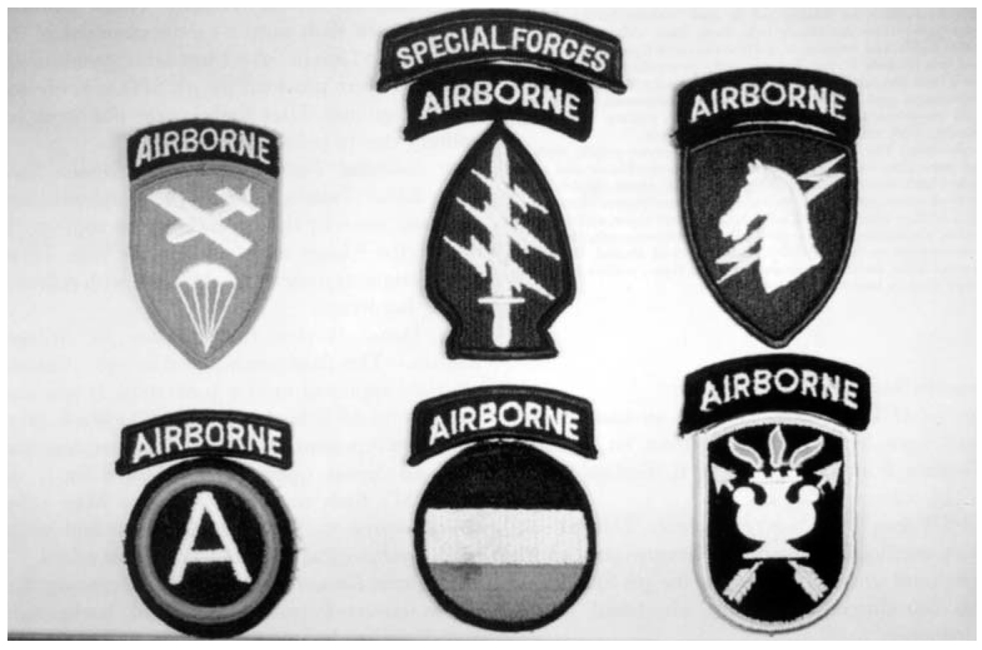
SF patches: (Top, L to R) Airborne Command, worn 1952–55—yellow lettering on black, white motifs on red; Special Forces, since 1955—yellow on teal blue, under yellow-lettered black Airborne tab, and yellow-lettered teal blue SF qualification tab dating from 1983; 1st Special Operations Command, since 1983—white horse, yellow lightning, green shield.
(Bottom) 3rd Army patch worn 1952–62 by Psychological Warfare Center and Special Warfare Center—white on blue, with red rim; Continental Army Command, worn by Special Warfare Center, 1962—white-on-blue tab, blue/white/red disc; Special Warfare Center and Institute for Military Assistance, since 1962—yellow-on-black tab, white lamp, yellow rim and arrows, red and yellow flames.
L5: SF Det. (Abn.) Korea. This detachment’s flash was adopted in the mid-1970s, and was based on the 1st SFGA’s with the addition of stripes representing the Korean colours.
L6: SF Field Epidemiological Survey Team (Abn.). The FEST flash was adopted in 1966, and incorporates the colours of the Medical Department. Upon arrival in Vietnam FEST initially wore the 5th SFGA flash in the mistaken belief that this was required due to its attachment to that group. This was corrected and FEST was again permitted to wear its flash from 27 June 1967.
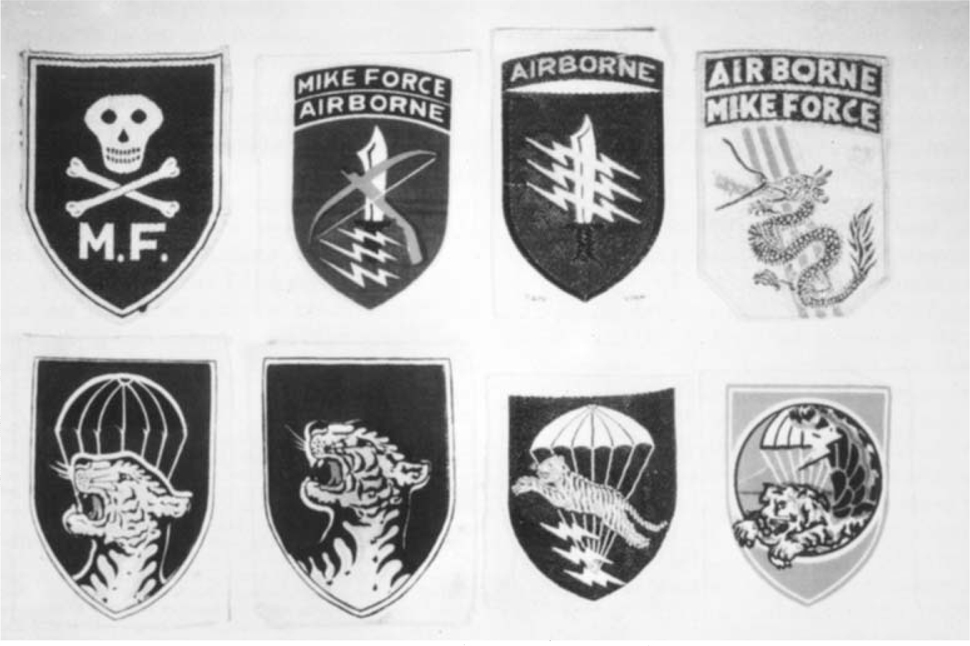
SF and CIDG patches: (Top, L to R) Mobile Strike Forces, 1965–67—white on black; 1st & 2nd Mobile Strike Forces, 1967–70—yellow on black tab, dark blue shield, black and white knife, red crossbow, yellow rim and lightnings; 3rd, 4th and 5th Mobile Strike Forces, 1967–70—yellow-on-black tab, dark blue shield with black rim, black and white knife, yellow lightnings; 2nd Mobile Strike Force Command, USSF only, 1968–70—basically white background, yellow and black details, with red flame and VN flag stripes.
(Bottom) The official Mobile Strike Forces patch, 1968–70, but note that other designs were retained—black and white ‘chute and natural-coloured tiger on dark green shield; Camp Strike Forces, 1968–70—same colouring, no ‘chute; Vietnamese SF (LLDB)—black shield, natural coloured tiger, other details white; Vietnamese Strategic Technical Directorate, the ARVN counterpart to MACV–SOG, 1967–75—red shield, light blue distant hills, natural coloured winged tiger, yellow lightning, other details black and white.
L7: 1st SFGA Advisors. This was an unauthorised flash worn by some advisors from 1st SFGA in Vietnam from 1961 to 1963. It displays the 1st SFGA colours.
L8: US Army SF Vietnam (Provisional). This flash was worn unofficially by some SF Vietnam personnel in 1963 until what was to become the 5th SFGA flash was introduced. Its colours are based on the Vietnamese flag.
L9: White Star Mobile Training Teams. Another unauthorised flash worn by some members of the WSMTT in Laos in 1961. Most detachments of the WSMTT were provided by 7th SFGA, hence the red background. Unit flashes were not worn in-country due to political sensitivity.
L10: Individual Training Group/Forces Armées Nationales Khmer Training Command. This unauthorised flash was worn by this organisation in 1971–72. It depicts the Khmer temple of Angkor Wat. There were variations without the stars and with different colour borders.
L11: Special Warfare Center/Institute for Military Assistance. This flash was adopted in 1961, but not officially approved until 2 June 1965. It was also worn by the SF School until 1981. The black, grey, and white represent the three levels of propaganda.
L12: 1st Special Operations Command (Abn.). 1st SOCOM’s flash was approved on 2 May 1983. Green represents SF, black Rangers, and white both psychological operations and civil affairs.
L13: Special Forces Background. It is interesting that this is universally considered the SF background and is worn by most units. However, it was originally approved for the 77th SFGA on 16 June 1954 and subsequently for the 7th. In the 1960s a number of new groups were formed primarily using cadres from the 7th. As these men transferred to the new units they brought with them the 7th SFGA’s background. It was incorrectly assumed that it was intended for wear by all SF units, as it matched the colours of the SF shoulder patch worn by all units. The fact is that any SF unit may request authorisation for a background matching or similar to its flash.
L14: 10th SFGA Background. This background was approved on 12 December 1952. For a brief period it was worn by the 77th SFGA in the mistaken belief that it was intended for all SF units. A variation with a maroon, rather than a red border was worn by some individuals in the early days.
L15: SF Det. (Abn.), Europe and 1st Bn., 10th SFGA Background. This background was approved at the same time as the flash.
L16: 11th SFGA Background. This background was approved on 1 November 1967. The group wore the SF background prior to this.
L17: SF Field Epidemiological Survey Team (Abn.) Background. This background was approved at the same time as the flash.
L18: Special Warfare Center/Institute for Military Assistance Background. This background was adopted at the same time as the flash.
L19: 1st Special Operations Command (Abn.) Background. This background was approved at the same time as the flash.
L20: Army Security Agency Dets. Background. In 1961 the 400th, 401st, 402nd, and 403rd ASA Dets. were, for a brief period, authorised to wear their own background even though they wore their parent groups’ flash. At the time the existence of these units was classified, and as a cover the background was officially listed for the 80th ASA Det. (Abn.) (Special Operations).